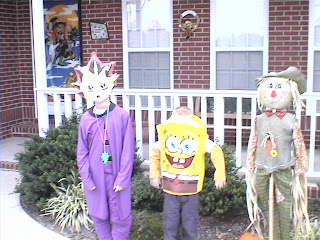
My thoughts on the celebration of Halloween is that the holiday is very much in need of an educational overhaul. Many who celebrate in the fashion that has become standard really have no clue to the history behind the celebration.
The one thing that we all can work at is reducing the waste that comes with this celebration.
Costumes that are unsafe and end up in landfills leaching toxic dyes and other chemicals into the ground....(Replace with a simple but interesting costume that can be put together at home with safe and reusable parts.)
Treats.....The biggie, so much junk food that no one needs nor benefits from, especially children.....(Replace with small containers of healthy tidbits, raisins, crackers, fruit chews, small apples, individual packs of hot coco mix, small collection ideas...such as stamps, arrowheads, rocks, etc.
( children love and enjoy what we as adults promote and make interesting for them.)
The best idea I have found is make the celebration about family and friends in your own back yard...a party designed with imagination and healthy, safe fun.
It's a wonderful time to visit the grave sites of relatives and share some family history. ( my parental family name has been traced all the way back to the Druids...it's amazing what you can learn with some dedicated searching.)
Greening is a broad term being used in the environmental arena as of late.
I believe it fits in many areas of application, especially the "waste" factor.
~Real History of Halloween~
Halloween's origins date back to the ancient Celtic festival of Samhain (pronounced sow-in).
The Celts, lived 2,000 years ago in the area that is now Ireland, the United Kingdom, and northern France. They celebrated their new year on November 1. This day marked the end of summer and the harvest and the beginning of the dark, often brutal winter, a time of year that was often associated with human death. Celts believed that on the night before the new year, the boundary between the worlds of the living and the dead became blurred. On the night of October 31, they celebrated Samhain, when it was believed that the ghosts of the dead returned to earth. In addition to causing trouble and damaging crops, Celts thought that the presence of the otherworldly spirits made it easier for the Druids, or Celtic priests, to make predictions about the future. For a people entirely dependent on the volatile natural world, these prophecies were an important source of comfort and direction during the long, dark winter.
To honor the event, Druids built large, sacred bonfires, where the people gathered to burn crops and animals as sacrifices to the Celtic deities.
During this celebration, the Celts wore costumes, often consisting of animal heads and skins, making predictions for each other and the coming year. When the celebration was over, they re-lit their hearth fires, which they had extinguished earlier that evening, from the sacred bonfire to help protect them during the coming winter.
By A.D. 43, Romans had conquered the majority of Celtic territory. In the course of the four hundred years that they ruled the Celtic lands, two festivals of Roman origin were combined with the traditional Celtic celebration of Samhain.
The first being Feralia, a day in late October when the Romans traditionally commemorated the passing of the dead. The second was a day to honor Pomona, the Roman goddess of fruit and trees. The symbol of Pomona is the apple and the incorporation of this celebration into Samhain probably explains the tradition of "bobbing" for apples that is practiced today on Halloween.
By the 800s, the influence of Christianity had spread into Celtic lands. In the seventh century, Pope Boniface IV designated November 1st All Saints' Day, a time to honor saints and martyrs. It is an accepted belief today that the pope was attempting to replace the Celtic festival of the dead with a related, but church-sanctioned holiday. The celebration was also called All-hallows or All-hallowmas (from Middle English Alholowmesse meaning All Saints' Day) and the night before it, the night of Samhain, began to be called All-hallows Eve and, eventually, Halloween. Even later, in A.D. 1000, the church would make November 2nd All Souls' Day, a day to honor the dead. It was celebrated similarly to Samhain, with big bonfires, parades, and dressing up in costumes as saints, angels, and devils. Together, the three celebrations, the eve of All Saints', All Saints', and All Souls', were called Hallowmas.
Enjoy, have fun, celebrate the history of you...where you came from and some spooky happenings along the way. Real history can be much more exciting than anything we can concoct.
This information I have put together from several history sources that are regarded as factual to the degree of mans ability to trace and record history.
Bea Kunz~


